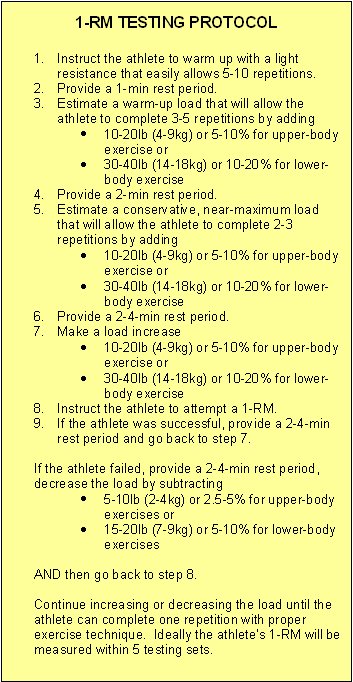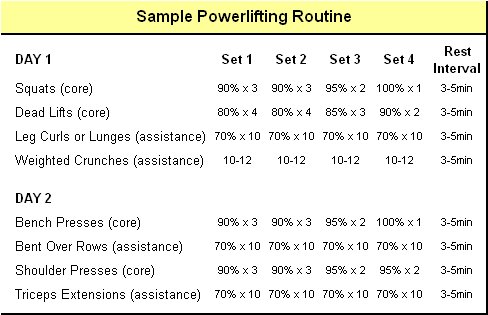A powerlifting routine can be one of the most intense and demanding forms of weightlifting. Although it will consist of relatively few exercises, each is completed with near maximal effort.
Power lifting is often confused with Olympic weightlifting. For the uninitiated, Olympic weightlifitng consists of two exercises – the clean & jerk and the snatch.
Powerlifting, on the other hand is made up of three lifts commonly performed in most commercial gyms – bench presses, squats and dead lifts. In both disciplines, competitors must lift as much weight for a single, qualifying repetition as possible. In powerlifting, the highest combined weight lifted for all three exercises constitutes the overall winning score.
You can see world records for combined and individual lifts at the official website of the The International Powelifting Federation
Exercise Selection
Selecting exercises for a powerlifting routine is relatively straightforward. Resistance exercises can be classed as either core (recruiting one or more large muscles groups such as the chest, shoulders or quadriceps) or assistance exercises (recruiting smaller muscle groups such as the biceps, trapezius and calf muscles).
While both types of exercises can be incorporated into a powerlifting workout, the emphasis should be on core exercises – and obviously bench presses, dead lifts and squats would take the highest priority. Note that “core” in this example is not to be confused with exercises that work the abdominal region.
Training Frequency
Depending on how a powerlifting routine is structured, the number of sessions per week will range from 2 to 5 up to a maximum of 6. Training status has the greatest impact on this with novice lifters training no more than 3 days per week. As competitive powerlifting involves lifting maximum loads (see Training Load & Repetitions below), athletes may require greater recovery time between sessions. There is also some evidence to suggest that lower body muscle groups require greater recovery time than upper body muscle groups.
Many powerlifting programs adopt a split routine in which different muscle groups are worked on different days. This allows the necessary recovery from maximal strength training while also allowing adequate volume for more experienced lifters. A simple split routine is to work the lower body (squats and dead lifts) on days 1 and 4 and the upper body (bench presses) on day 2 and 5. As simplistic as this routine is, it works well and lends itself to maximal training.
Training Load & Repetitions
Powerlifting involves maximal effort for a single repetition and so training should reflect this. An athlete’s ability to generate maximal strength not only depends on the cross-sectional area of the muscle (i.e. muscle size) but the ability to recruit and synchronize all the fast twitch fibres involved in the action. Lifting near maximal loads (greater than 80% one repetition maximum) is necessary in order to recruit these fast twitch fibres. Using a smaller load and increased number of repetitions (as in bodybuilding) will result in significant hypertrophy but not the associated neuromuscular changes required for maximum lifting.
A powerlifting routine should employ loads of 80-100% one repetition maximum (1-RM) in repetition ranges of 1-8. The majority of training will come from the highest end of this loading scale (i.e. 100-93% 1-RM x 1-3 repetitions) with lower weights and higher reps reserved for the beginning of the program and recovery weeks.
In order to determine a suitable load for a power lifting routine, 1-RM testing must be completed. This only needs to be for the 3 core exercises – bench press, dead lifts and squats. Here is the protocol for 1-RM testing as set out by the National Strength & Conditioning Association:

Volume
To quickly recap…
A powerlifting routine should be centered around core exercises and in particular, the bench press, dead lifts and squats. Training frequency should be 3-5 days per week and splitting the routine into upper and lower body sessions allows for the most efficient work to recovery ratio. The most relevant training adaptation will be achieved with sets of 1-3 repetitions using loads of 93-100% 1-RM. Lighter sets and higher repetitions can be used to vary volume and intensity over the course of the program.
Volume is the total amount of weight lifted in a training session or series of training sessions. In untrained individuals, single sets have been shown to increase maximal strength. However, in more experienced lifters higher volumes are required in order to promote further strength gains. In fact, studies have shown that 3 sets without reaching failure in any set, enhances strength to a greater degree than 1 set performed to failure.
For single-effort power events (such as powerlifting) 3-5 sets has been shown to be an optimal training volume. This of course, presupposes repetitions are kept to in the 1-3 range. Volume should be significantly for a powerlifting routine compared to a bodybuilding routine. Where a bodybuilder’s aim to is to completely exhaust every muscle group, maximal strength training cannot be completed effectively in such a fatigued state.
Rest Periods
Longer rest periods between sets and exercises are also required for a powerlifting routine. Hypertrophy (increases in muscle size) responds best to rest periods in the 30-90 seconds range. However, for maximal strength training this is not long enough. Rest intervals of 2-5 minutes have been shown to result in greater strength and power gains than 30 seconds rest intervals. Remember, that to a large degree, maximal strength development relies on the ability to create maximum tension in the muscle – which is directly related to fast twitch fibre recruitment – and is severely hindered by fatigue.
Periodization
Periodization can be defined as breaking an overall training program into periods or cycles each with a specific outcome, and incorporates variations in training specificity, intensity, and volume. In comparison, a traditional bodybuilding routine is purely progressive in nature – the goal is simply to lift heavier and heavier weight each time. Every session and exercise is performed with maximal effort. Which is a more favorable approach for a powerlifting routine – periodized or progressive?
Most elite athletes (across a range of sports) favor a periodized strength program. Through structured peaks and troughs in training volume and intensity, the athlete is more likely to hit a peak just when they need it. More importantly, the risk of over training (which can be particularly high in a power lifting routine) is reduced with a cycling system.
Periodization is also more suitable for beginners or less experienced lifters. A novice athlete should not jump straight into to using near maximum loads and should reduce both volume and training frequency. It can take as long as 10-12 weeks of functional strength training, with relatively lighter loads to prepare a younger, inexperienced lifter for maximal strength training.
Sample Program
Here is sample program for one phase (6-10 weeks) of training in a longer-term powerlifting routine. Beginners should complete an anatomical adaptation routine for at least 8 weeks before moving on to a program like this. Such a routine would incorporate more exercises to prepare all the joints, ligaments and connective tissue for more intense training.
This program does not include variations in volume and training load that more experienced lifters would benefit from. At the very least volume would taper towards the competition date.

This routine would be completed for a total of 4 sessions per week. For example, Monday = Day 1, Tuesday = Day 2, Wednesday = Rest Day, Thursday = Repeat Day 1, Friday = Repeat Day 2, Saturday & Sunday = Rest Days.
The sets above do not include warm up sets. Two or three sets of at least 8-10 repetitions should be completed before each exercise.
It goes without saying that this powerlifting routine is not for beginners and a significant strength base should be in place before attempting something like it. Lifting maximum loads should ideally be completed inside a power rack and always under the supervision of a competent spotter.

Jacky has a degree in Sports Science and is a Certified Sports and Conditioning Coach. He has also worked with clients around the world as a personal trainer.
He has been fortunate enough to work with a wide range of people from very different ends of the fitness spectrum. Through promoting positive health changes with diet and exercise, he has helped patients recover from aging-related and other otherwise debilitating diseases.
He spends most of his time these days writing fitness-related content of some form or another. He still likes to work with people on a one-to-one basis – he just doesn’t get up at 5am to see clients anymore.